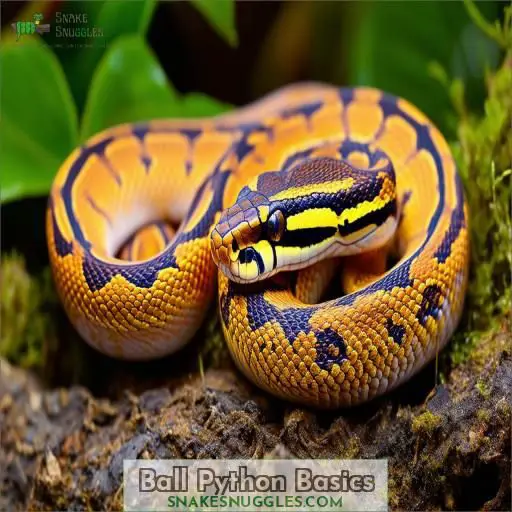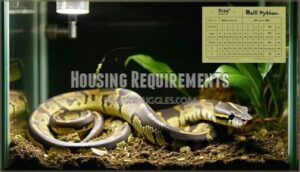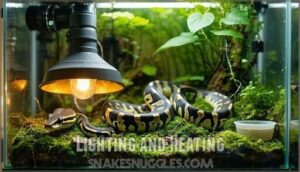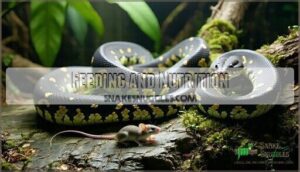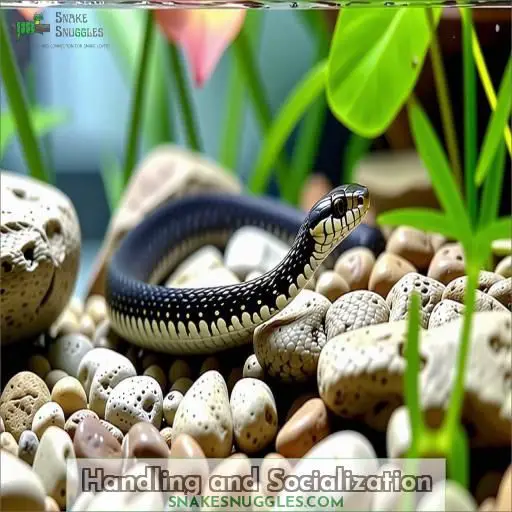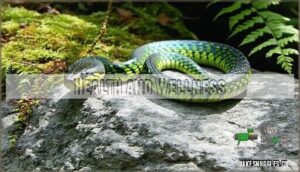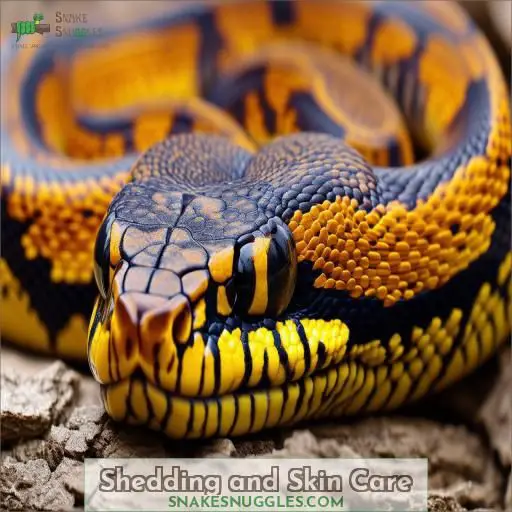This site is supported by our readers. We may earn a commission, at no cost to you, if you purchase through links.
 As a beginner ball python owner, you’ll need to provide the right environment for your new pet’s health and happiness.
As a beginner ball python owner, you’ll need to provide the right environment for your new pet’s health and happiness.
Start with a properly sized enclosure, appropriate substrate, hides, and decor.
Maintain temperatures between 75-95°F using heat sources like under-tank heaters, and keep humidity around 50-60%.
Feed appropriately sized rodents every 7-10 days, and supplement with calcium occasionally.
Gently handle your snake after an acclimation period, building trust gradually.
By understanding ball python care essentials like heating, humidity, feeding, and handling, you’ll guarantee your scaly friend thrives.
Want to delve deeper into creating the ideal setup?
Table Of Contents
- Key Takeaways
- Ball Python Basics
- Housing Requirements
- Temperature and Humidity
- Lighting and Heating
- Feeding and Nutrition
- Handling and Socialization
- Health and Wellness
- Shedding and Skin Care
- Breeding and Reproduction
- Ball Python Morphs
- Frequently Asked Questions (FAQs)
- How to take care of a ball python for beginners?
- What to know before getting a ball python?
- How to handle a ball python for the first time?
- What all do I need for a ball python?
- How often should the enclosure be deep cleaned?
- Is it safe to house two ball pythons together?
- Do ball pythons recognize and bond with their owners?
- At what age can ball pythons start breeding?
- Are there any special considerations for feeding during brumation?
- Conclusion
Key Takeaways
- As a rookie reptile wrangler, arm yourself with the sacred knowledge: providing the perfect palace, with cozy caves and a climate-controlled sanctuary, is the key to your scaly companion’s contentment.
- Fear not the feeding frenzy, young serpent seeker! Mastering the art of supplying appropriately-sized morsels and calcium supplements will ensure your slithering sidekick stays healthy and vibrant.
- Ah, the delicate dance of handling! Approach with patience, grasshopper, and allow your reptilian friend to slowly warm to your calming presence, building an unbreakable bond of trust.
- Keep a watchful eye, noble novice, for any signs of ill health or shedding woes. A swift consultation with a seasoned reptile sage could mean the difference between a thriving companion and a dire situation.
Ball Python Basics
Ball pythons are a fascinating reptile known for their docile nature and unique ability to curl into a tight ball—hence their name.
These snakes, native to Africa, come in various beautiful colors and patterns, each with its own unique personality.
As a potential owner, you’ll want to understand their specific care requirements for housing, temperature, humidity, and diet to ensure your ball python thrives.
With the right knowledge and setup, these gentle creatures make rewarding and low-maintenance pets.
Housing Requirements
Providing your ball python with a suitable enclosure is imperative for its well-being. The enclosure should be large enough to accommodate the snake’s adult size, typically a minimum of 40 gallons for an adult ball python, and should include appropriate substrate, hides, and natural-looking decor to replicate the snake’s natural environment.
Enclosure Size
You’ll want to make certain proper enclosure size for your ball python’s growth rate, which can be found in the growth stages and milestones section. As a juvenile, provide at least a 10-gallon enclosure, upgrading to:
- 20-gallon tank for young adults
- 40-gallon enclosure for fully-grown adults
- 4x2x2 feet PVC or wooden enclosure for large adults
Inadequate space causes stress and health issues. Observe your python’s size closely to make certain its home accommodates its body comfortably.
Substrate
You’ll need a suitable substrate that holds humidity well while remaining easy to spot-clean. An ideal option is cypress mulch or coconut fiber. Avoid cedar, as its oils are toxic.
| Material | Moisture Retention | Ease of Cleaning |
|---|---|---|
| Cypress Mulch | High | Moderate |
| Coconut Fiber | High | Moderate |
| Aspen Shavings | Low | High |
| Newspaper | Low | High |
Choose a substrate that balances moisture, cleanliness, and your python’s preferences.
Hides and Decor
You’ll need to provide your ball python with at least two hides – one on the warm side and one on the cool side. Suitable options include:
- Cork bark rounds or half-logs
- Plastic storage containers with entrance holes
- Upturned flower pots or plant saucers
- PVC pipes or tubes
- Commercially available reptile hides
Change out hides occasionally for cleaning and enrichment.
Temperature and Humidity
To maintain proper temperature and humidity levels for your ball python’s enclosure, you’ll need to provide appropriate heating sources and closely monitor conditions. A regulated under tank heater or ceramic heat emitter can create the necessary thermal gradient, while a large water bowl helps sustain ideal humidity between 50-60%.
Heating Sources
You’ll need an appropriate heating source to recreate ball pythons’ thermal needs.
Heat mats or radiant heat panels allow for warm and cool zones. Ceramic heaters and infrared bulbs provide ambient heat.
Aim for a temperature range of 75-80°F on the cool end and 90-95°F on the warm basking area.
Proper heating is vital for metabolism, digestion, and overall health.
Speak with your vet if unsure about ideal heating sources and temperatures.
Humidity Levels
You’ll need to maintain proper humidity levels for your ball python’s enclosure, around 50-60%.
Inadequate humidity can lead to dehydration and shedding issues.
While excessive moisture fosters bacteria and mold growth.
Monitor substrate dampness, using a spray bottle to mist as needed.
Provide a large water bowl and ensure sufficient ventilation.
humidity regulation is critical for your pet’s well-being and longevity.
With proper care, these snakes can live over 30 years!
Lighting and Heating
You’ll need to provide your ball python with a properly heated basking area, allowing it to thermoregulate and maintain ideal health. At night, lower the temperature to imitate their natural environment, but make sure it doesn’t drop too low, as this could jeopardize their well-being.
Basking Area
You’ll need a basking area for your ball python, allowing it to thermoregulate and digest properly. Here are some tips:
- Provide an overhead heat source, like a ceramic heat emitter or basking bulb
- Aim for a basking spot around 88-92°F (31-33°C)
- Ensure the basking area covers only part of the enclosure, creating a thermal gradient
Monitor temperatures closely using digital thermometers. Proper basking is crucial for your snake’s metabolism, digestion, and overall well-being. With the right setup, your ball python can thrive.
Nighttime Temperatures
At night, you’ll need to mimic their natural environment by allowing a cooler temperature drop to around 75-80°F.
Nighttime cooling encourages natural behaviors like burrowing and triggers brumation if desired. Be wary of extreme lows, though, as anything under 70°F can stress your ball python.
Use ceramic heaters carefully, monitoring with precise thermometers. Improper nighttime conditions disturb feeding and activity patterns.
Pay close attention to optimize their health and comfort.
Feeding and Nutrition
When feeding your ball python, you’ll need to carefully consider the appropriate prey size and establish a proper feeding schedule. An adequately sized rodent, typically equal to the widest part of the snake’s body, should be offered on a regular basis, with the frequency depending on the snake’s age, size, and overall health.
Prey Size
Choosing the right prey size is essential for your ball python’s well-being. They prefer to consume prey items that are no larger than 1.5 times the widest part of their body. Here are three key factors that need to be taken into account:
- Age and size of the snake
- Type of prey (mice, rats, gerbils)
- Frequency of feeding
Offering properly-sized prey helps prevent digestive issues, regurgitation, and potential injuries from handling oversized food items. Ball pythons are adept at size discrimination, so let their hunting behavior and food preferences guide your choices.
Feeding Schedule
You’ll want to feed your ball python appropriately-sized prey once every 7-10 days.
Variety is key for their health, so rotate between different frozen rodents like mice, rats, and gerbils.
Supplement occasionally with calcium and vitamin D3 to prevent deficiencies.
Try enriching feedings by scattering prey around the enclosure to encourage natural hunting behaviors.
Pay close attention to your snake’s food preferences and adjust accordingly.
Handling and Socialization
Proper handling is essential for keeping your ball python calm and content. With gentle care and a brief acclimation period, ball pythons typically become docile companions that can be handled regularly.
Proper Handling Techniques
Now that your ball python’s enclosure and diet are set up, proper handling is imperative. Approach calmly and let your snake get used to your scent before attempting to pick it up. Here are three key tips:
- Support the body fully
- Never grab the head area
- Limit handling after meals
With patience and gentle handling, your ball python will become accustomed to your presence. Socialization through enrichment activities like hiding boxes and climbing branches can also help build trust.
Acclimation Period
Before handling your new ball python, allow for an acclimation period of 7-10 days. During this time, observe their feeding habits and enclosure cleanliness. A new owner’s concerns like proper socialization techniques and potential health issues can be addressed once the snake feels secure.
| Day | Activity |
|---|---|
| 1-3 | Leave snake undisturbed |
| 4-6 | Introduce hand in enclosure |
| 7-10 | Begin brief handling sessions |
After this adjustment phase, gradually increase handling to build trust with your new reptile companion.
Health and Wellness
It’s critical to monitor your ball python’s health regularly by observing their behavior, appetite, and overall appearance. Signs of illness may include lethargy, loss of appetite, regurgitation, abnormal droppings, skin issues, or other concerning symptoms – if any are noticed, seeking prompt veterinary care from an experienced reptile vet is highly recommended.
Signs of Illness
You’ll want to monitor your ball python’s health closely. Warning signs include:
- Loss of appetite or weight loss
- Discharge from the mouth, nostrils, or vent
- Abnormal shedding or skin issues
Early detection is imperative for successful treatment. Maintain proper husbandry to prevent illness caused by inadequate heat, moisture, or unsanitary conditions. Consult an experienced reptile vet promptly if you notice worrying symptoms – they can diagnose and treat snake ailments effectively.
Veterinary Care
You should establish a relationship with a reptile vet, as ball pythons require specialized care. Regular checkups guarantee preventative care and early detection of issues. Prepare for potential veterinary expenses related to emergency care, medication, or treatments. Some owners opt for pet insurance to offset costs. Here’s a table summarizing key veterinary aspects:
| Aspect | Importance |
|---|---|
| Preventative Care | Maintains health, catches issues early |
| Emergency Care | Addresses injuries, illnesses promptly |
| Medication Effects | Understand impacts on snake’s behavior, appetite |
Building trust with a qualified vet guarantees your ball python receives exceptional care throughout its life.
Shedding and Skin Care
Shedding is a natural process for ball pythons as they grow, occurring every few weeks for juveniles and several times a year for adults. To facilitate healthy shedding, maintain proper humidity levels of 60-70% in their enclosure, allowing the old skin to peel off smoothly and completely.
Shedding Process
Ball pythons shed their skin regularly.
Younger snakes shed more frequently than adults.
As they prepare to shed, their eyes will cloud over and their skin will turn dull.
During this process, they may behave differently, becoming more reclusive or irritable.
After shedding, gently remove any remaining skin and maintain proper humidity to aid future sheds.
Post-shed snakes often show vibrant colors and patterns.
Proper shedding indicates good health, so address any shedding problems promptly.
Humidity Requirements
To safeguard your ball python’s proper shedding process, it’s imperative to maintain adequate moisture levels within its enclosure. Strive for:
- ️ 55-60% prevalent humidity
- 70-80% humidity within the shedding shelter
- Misting the enclosure periodically
- Utilizing moisture-retaining substrates
Variations in humidity can result in hindered shedding, thus, it’s crucial to closely monitor levels. Proper ventilation facilitates airflow while preventing stagnant conditions. With the appropriate moisture gradient, your snake will shed effortlessly, fostering healthy skin and scale growth.
Breeding and Reproduction
If you plan to breed your ball pythons, be mindful of their breeding season, which typically runs from late fall to early spring. During this period, you’ll need to prepare for egg incubation by setting up a suitable environment with the proper temperature and humidity levels to guarantee successful hatching.
Breeding Season
When breeding ball pythons, you’ll need separate breeding enclosures.
During the cooler months, these snakes enter breeding condition and their mating behavior begins. Males will court females through body movements and pheromones.
After a successful mating, the female will ovulate and retain sperm, laying fertilized eggs around 30-60 days later.
Proper breeding enclosures and understanding their reproductive cycle are essential for successful ball python breeding.
Egg Incubation
After mating, you’ll need to carefully monitor the female for egg development and prepare an incubation setup.
Proper egg handling and monitoring are essential for successful hatching.
Maintain suitable humidity levels and temperatures during incubation. Be prepared to address issues like infertile eggs or mold growth.
With diligent care and attention to detail, you can achieve a high egg fertility rate and healthy hatchlings.
Ball Python Morphs
One of the most fascinating aspects of ball python ownership is the incredible variety of morphs available. Morphs refer to genetic variations that result in distinct color patterns and markings, ranging from the classic wild-type to striking albino, piebald, and other alluring combinations of hues and designs.
Common Morphs
You’ll find ball pythons come in a dazzling array of morph patterns due to selective breeding and genetic inheritance. Common examples include the Albino with recessive traits eliminating pigment, Spider with intricate web-like patterns from a recessive gene, and Pastel displaying vibrant, almost iridescent color variations. Expanding captive breeding programs continuously introduce exciting new morphs to explore.
Genetic Traits
Regarding ball python morphs, you’re dealing with genetic characteristics. These unique colors and patterns are the result of:
- Recessive alleles
- Dominant traits
- Polygenic inheritance
- Genetic variation
Comprehending the underlying genetics empowers you to selectively breed for desired morphs while guaranteeing a healthy lineage. With meticulous breeding practices, you can produce striking visual varieties while preserving the species’ vigor and diversity.
Frequently Asked Questions (FAQs)
How to take care of a ball python for beginners?
As the adage goes, Proper preparation prevents poor performance. Provide an appropriate enclosure with the right temperature, humidity, and hiding spots for your ball python. Feed appropriately sized prey items, and handle calmly to establish trust. With patience and consistency, you’ll master ball python care.
What to know before getting a ball python?
Before acquiring a ball python, thoroughly investigate their housing, feeding, and handling requirements. Verify your ability to provide the appropriate enclosure, diet, and minimal handling for 20-30 years. Consider the costs of veterinary care and supplies as well.
How to handle a ball python for the first time?
Uncover the serpent’s secrets, newcomer. Gently drape it over your palms, support its midsection. Allow its tongue to brush your skin curiously as you gain its trust through patience and care – a bond blossoming like scales unfurling.
What all do I need for a ball python?
You’ll need the following: a secure enclosure (40+ gallon tank), aspen bedding, hides, water bowl, heat lamps, thermometers, humidity gauges, and frozen rodent prey. Thorough research on their specific needs is essential for proper care.
How often should the enclosure be deep cleaned?
You should thoroughly clean your ball python’s enclosure every 1-2 months. Spot-clean daily by removing feces and urates, while monthly cleanings include disinfecting, replacing substrate, and scrubbing surfaces.
Is it safe to house two ball pythons together?
Rhetorical start: Let’s venture into the reptile domain. It’s generally not advised to cohabit ball pythons, as these solitary serpents may become aggressive and territorial, potentially leading to injuries or worse.
Do ball pythons recognize and bond with their owners?
While ball pythons don’t bond like mammals, they can become accustomed to their owners through regular, gentle handling. This habituation process helps them feel secure and recognize you as a non-threatening presence.
At what age can ball pythons start breeding?
In the days of old, ball pythons were ready to breed at 2-3 years old. As a responsible owner, ascertain they’ve reached proper size – males around 700g, females 1,500g – before considering breeding these fascinating reptiles.
Are there any special considerations for feeding during brumation?
During brumation, it’s essential to refrain from feeding your ball python. Their metabolism slows down considerably, and attempting to feed them could cause unnecessary stress.
Conclusion
By mastering ball python care essentials like housing, temperature, humidity, feeding, handling, health monitoring, understanding that ball pythons have a more docile but shy temperament compared to curious corn snakes, shedding support, and understanding morphs, you’ll guarantee these fascinating reptiles flourish in captivity. Providing a suitable environment customized to their specific needs ensures your scaly friend lives a long, healthy, and enriched life as a cherished pet.

